

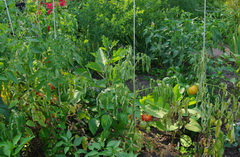
This is a year for strange behaviour in the garden. Not mine, the plants. One row of Tomato plants, Big Beef variety, are constantly wilting while the other three rows, which actually all converge at the centre of the Tomato structure, are all doing fine. Each row is a different variety but I have trouble believing that the wilting phenomenon is a varietal difference but I cannot pinpoint anything else that would be causing it. We have had a nice sufficiency of rain lately but still they wilt??? Over just to the South is a row of Eggplant. These are plants that I purchased when many of my seedlings where succumbing to an aphid attack. The plants grew a little, they are now about 15cm (6") tall and they haven’t grown any more in weeks but they are flowering and producing small fruit that is actually laying on the ground and these are not a dwarf variety. I’m confused and I’m supposed to be some sort of knowledgeable gardening guru. 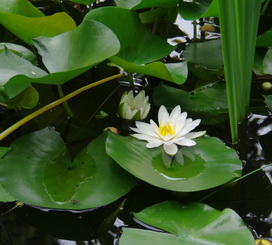 The Cabbage are huge and delicious and many of the Pepper plants are producing well and they are right beside the dwarfed Eggplant. The Water Lilies in the two shallower ponds are such a jungle of leaves and blooms that I can hardly see any water. I know that they have escaped their pots and are established in the thick rich muck at the bottom of the ponds. That’s what makes me reluctant to clean out those ponds. Besides the water is staying nice and clear this year as it passes through my two simple filters. One is a basket of filter cloth that I rinse out occasionally and the new one is a good sized basket of plants, planted in just 3/8 marble chips, that the water must flow through to get down the river. Those plants are growing very well, as they find a quantity of fish poo to filter out of the water, and the water coming out the other side is nicely cleared up. Simple, effective, natural and totally hidden as a filtering device.
The Cabbage are huge and delicious and many of the Pepper plants are producing well and they are right beside the dwarfed Eggplant. The Water Lilies in the two shallower ponds are such a jungle of leaves and blooms that I can hardly see any water. I know that they have escaped their pots and are established in the thick rich muck at the bottom of the ponds. That’s what makes me reluctant to clean out those ponds. Besides the water is staying nice and clear this year as it passes through my two simple filters. One is a basket of filter cloth that I rinse out occasionally and the new one is a good sized basket of plants, planted in just 3/8 marble chips, that the water must flow through to get down the river. Those plants are growing very well, as they find a quantity of fish poo to filter out of the water, and the water coming out the other side is nicely cleared up. Simple, effective, natural and totally hidden as a filtering device.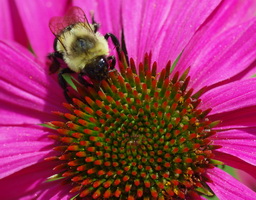 Was at the University of Guelph’s trial grounds for Annuals and some Perennials the other day and saw a wonderful mix of old and new varieties. This is an All America Selections trial ground so there are always a few unnamed varieties that are being tested for that program and we can have a sneak peek at them. I saw a couple of amazing Lisianthus, one of my favourite cut flowers, growing in the ground. They are apparently cut flower varieties that were performing very well as late blooming annuals. I had the good sense to put the macro lens on my camera, knowing that I would get some wonderful opportunities for close up shots of a wide range of flowers. I’m usually not a great fan of Echinacea but there was this rich dark pink variety, one of series known as Knee High, that was only about 30cm tall and covered with flowers. While photographing it, a large bumblebee decided to land and crawl into the centre of my shot. Right time, right place and be ready to move quickly is the secret to many a good photograph. We got several similar pictures that day as the whole garden was buzzing with a variety of insects that were sampling the nectar. I wonder if the All America people have ever thought of asking the insect population to rate their new award winners.
Was at the University of Guelph’s trial grounds for Annuals and some Perennials the other day and saw a wonderful mix of old and new varieties. This is an All America Selections trial ground so there are always a few unnamed varieties that are being tested for that program and we can have a sneak peek at them. I saw a couple of amazing Lisianthus, one of my favourite cut flowers, growing in the ground. They are apparently cut flower varieties that were performing very well as late blooming annuals. I had the good sense to put the macro lens on my camera, knowing that I would get some wonderful opportunities for close up shots of a wide range of flowers. I’m usually not a great fan of Echinacea but there was this rich dark pink variety, one of series known as Knee High, that was only about 30cm tall and covered with flowers. While photographing it, a large bumblebee decided to land and crawl into the centre of my shot. Right time, right place and be ready to move quickly is the secret to many a good photograph. We got several similar pictures that day as the whole garden was buzzing with a variety of insects that were sampling the nectar. I wonder if the All America people have ever thought of asking the insect population to rate their new award winners. 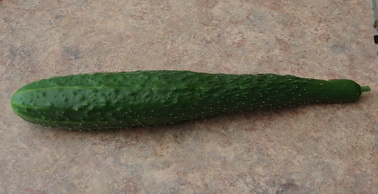 I have discovered a delightful Cucumber variety this year. I don’t particularly like Cukes but the Assistant Gardener loves them and therefore I grow a few. I like the look of them covering my tall obelisk with their large leaves and bright yellow flowers. Taste of Asia is a long thin variety that needs to be peeled before you eat it as it has a very prickly unfriendly skin. Inside the taste is sweet and almost Watermelon like. I even eat a few slices some nights. A plate of fresh sliced Cucumbers is one of her favourite appetizers before dinner and incredibly easy to do.
I have discovered a delightful Cucumber variety this year. I don’t particularly like Cukes but the Assistant Gardener loves them and therefore I grow a few. I like the look of them covering my tall obelisk with their large leaves and bright yellow flowers. Taste of Asia is a long thin variety that needs to be peeled before you eat it as it has a very prickly unfriendly skin. Inside the taste is sweet and almost Watermelon like. I even eat a few slices some nights. A plate of fresh sliced Cucumbers is one of her favourite appetizers before dinner and incredibly easy to do.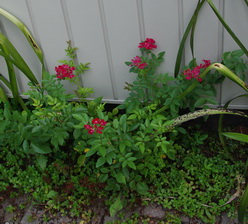 Oso Happy, Candy Oh, a vivid red landscape Rose is another new plant that has performed very well this summer. Most of the dwarf Roses I have tried, eventually put out great long growths that greatly exceed the space I allotted for a dwarf shrub. Candy Oh has maintained its short dense habit and has managed to have a reasonable show of its small red flowers all summer. It is growing in a very unfriendly location about 20cm wide between a walkway and the south facing wall of the house. Hot and dry, competing with some Sedum and not the best soil and it has still done very well. It is one of the Proven Winners group of plants that are available in most garden centres. You should give it a try, if it fits into your garden plan.
Oso Happy, Candy Oh, a vivid red landscape Rose is another new plant that has performed very well this summer. Most of the dwarf Roses I have tried, eventually put out great long growths that greatly exceed the space I allotted for a dwarf shrub. Candy Oh has maintained its short dense habit and has managed to have a reasonable show of its small red flowers all summer. It is growing in a very unfriendly location about 20cm wide between a walkway and the south facing wall of the house. Hot and dry, competing with some Sedum and not the best soil and it has still done very well. It is one of the Proven Winners group of plants that are available in most garden centres. You should give it a try, if it fits into your garden plan.Time to answer a few questions and then get back into the garden. If you have a gardening question just ‘reply’ to this newsletter and send me your query. I try to answer most of the questions and the ones that I answer here are those that I think will have the widest interest. You can also find the latest garden updates on the front page of gardening-enjoyed . 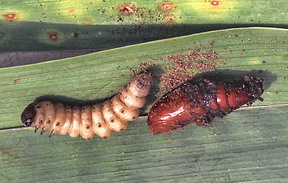 Paula Asks ? Weeding around my iris I happen to pull out a few plants and discovered the dreaded Iris borer. I did this again in another group of iris in yet another bed and found the borer again. In both places the plants above ground appear in perfect health no discolouration or spots on the leaves at all. My question is does the Iris borer always live near the plants or have I just caught him in the early stages of an attack?
Paula Asks ? Weeding around my iris I happen to pull out a few plants and discovered the dreaded Iris borer. I did this again in another group of iris in yet another bed and found the borer again. In both places the plants above ground appear in perfect health no discolouration or spots on the leaves at all. My question is does the Iris borer always live near the plants or have I just caught him in the early stages of an attack?Ken Answers! You have the life cycle backwards. At this time of year you are most likely to discover the Iris Borer as a dark brown pupa in the soil near the Iris plants. He, or possibly she, who can tell, has already tunnelled his way down inside the leaves of your Iris and likely hollowed out a large piece of rhizome. The damage is there if you look closely at the leaves or dig out the nearest rhizomes. With most of the rhizome gone, the plants ability to survive and grow is greatly reduced and it will soon fail and be unlikely to return next spring. That, almost immobile, pupa that you found will eventually produce a dull grey moth that will lay a batch of eggs and that is the form in which this ugly beast spends the winter. 111 Trent St. W. Whitby ON L1N1L9 |
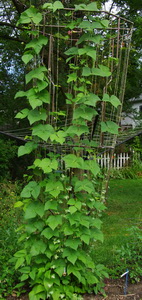 The
The 